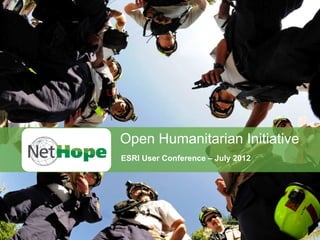
Open Humanitarian Initiative - ESRI User Conference Presentation
- 1. Open Humanitarian Initiative ESRI User Conference – July 2012
- 5. 5
- 6. 6
- 7. 7
- 9. Information is not being shared Decisions are made based on experience, not actual information Information is outdated before the map gets published Information management capacity is severely limited Listen to the affected community? Who are they? What do they know about disasters? 9
- 10. Disaster response continues to be rated as “poor” with the lack of information flow cited as one of the main reasons “The difficulties encountered in “The response to the Haiti establishing an appropriate Earthquake in 2010 was a system for collecting and missed opportunity to analyzing data in order to provide translate the quick setting up decision‐makers with information of cluster coordination and the in a timely manner” were cited as availability of substantial one of the main reasons of poor resources into timely results” response Earthquake in Haiti Real Time Evaluation report found that “the overall results “The information flow was massive are considered to be both but with limited strategic usage (i.e. ‘scattered’ and ‘patchy’” decision making and prioritization)” Floods in Pakistan Disaster in Darfur Having access to the right information seems to be one of the main factors that determines the difference between life and death 10
- 11. Granular issues • Lack of process standardization on how humanitarian data is Process represented during data exchange • Lack of access to the most current information required by Technology responders to make fully informed decisions • Lack of a common platform for securely sharing humanitarian data • Lack of capacity to share, manage, analyze and disseminate Organization humanitarian data both at the national and international level • Lack of willingness to share humanitarian information Governance 11
- 12. Open Humanitarian Initiative STREAM1 - TECHNOLOGY STREAM2 - CAPACITY BUILDING Main Objective: Main Objective: • Improve information sharing between • Improve information management capacity both humanitarian organizations within local and international humanitarian organizations as well as within governments and first responders in disaster prone countries 12
- 13. Six project areas in two streams Project Deliverables Impact 1 • Interoperability: Data standards will be • Governments, NGOs and humanitarian STREAM1 - TECHNOLOGY defined to ensure consistent organizations will be able to move and terminology and to enable data sharing share information between different technical solutions 2 • Data Sharing Platform: A data sharing • Ensures data can be shared remotely platform will combine, store and share between organizations and can be humanitarian response data using the accessed from any location enabling data standards schemas defined better decision making 3 • Visualization: An interface will be • Organizations and responders will be able created where data can be processed, to visualize the required data in the ideal analyzed and displayed in different format formats such as graphs, tables, charts, dashboards, maps etc… 4 • Capacity Building: Local disaster • People trained in using information management authorities as well as management tools, such as the OHI humanitarian organization staff will be platform, leading to better crisis STREAM2 - CAPACITY trained in the use of information information management management tools, such as the OHI platform BUILDING 5 • Digital Volunteers: Local and global • Culture of information management digital volunteer communities will be established, leading to an increase in created, fostered and trained in the use responder capacity and data availability of information management tools 6 • Research and Innovation: A culture of • Increase in the quality of the analysis research and innovation established performed resulting in increased OHI tool within the information management effectiveness field in disaster prone regions 13
- 14. Bringing together a broad set of potential partners is a key success factor Subset of potential partners Role within OHI Global Technology Companies • Support with the design and implementation of the data platform, visualization and interoperability • Provide the technology such as hosting services and software • Provide guidance and in-kind development support Academic Institutions • Support with the research and innovation approach • Help with training and learning material • Provide guidance and in-kind support Humanitarian Institutions • Support with the overall project • Provide guidance and leadership • Provide in-kind support 14
- 15. You can take part in OHI and provide… Technology Expertise Time Training Funding Open data Mentoring Photo courtesy of Save the Children 15
- 16. Get involved as a digital volunteer… 16
